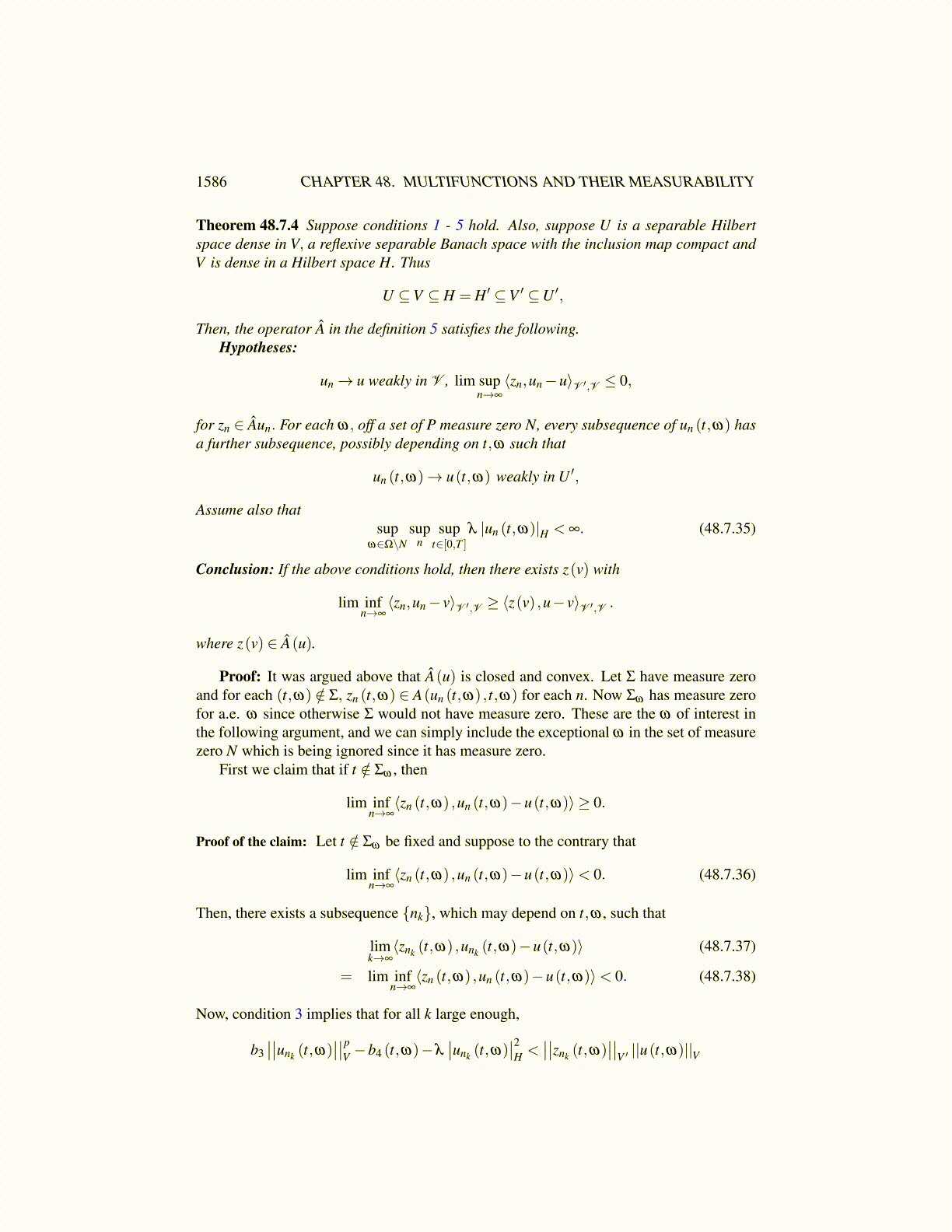
1586 CHAPTER 48. MULTIFUNCTIONS AND THEIR MEASURABILITY
B(w, 1
k
)⊆ L2 (Sp;V ′) with respect to the strong topology, there is a convex combination
∑∞j=k c jkŵ j (the c jk add to 1 and only finitely many are nonzero). Since G(t) is convex
and closed, this convex combination is in G(t). Off a set of measure zero, we can assumethis convergence of ∑
∞j=k c jkŵ j as k→ ∞ happens pointwise for a suitable subsequence.
However,∞
∑j=k
c jkŵ j (t) ∈Uk (t)⊆ A(u(t) , t)+B(
0,2k
).
Thus w(t) ∈ A(u(t) , t) a.e. t because A(u(t) , t) is a closed set. Since w is the pointwiselimit of measurable functions off a set of measure zero, it can be assumed measurable andfor a.e. t, w(t) ∈ A(u(t) , t)∩G(t). Now denote this measurable function wn. Then
wn (t) ∈ A(u(t) , t) ,⟨wn (t) ,u(t)− y(t)⟩ ≤ α (t)+1n
a.e. t
These wn (t) are bounded for each t off a set of measure zero and so by Lemma 48.7.1, thereis a measurable function t→ z(t) and a subsequence wn(t) (t)→ z(t) weakly as n(t)→ ∞.Now A(u(t) , t) is closed and convex, hence weakly closed as well. Thus z(t) ∈ A(u(t) , t)and
⟨z(t) ,u(t)− y(t)⟩ ≤ α (t) = lim infk→∞⟨znk (t) ,unk (t)− y(t)⟩ (**)
Therefore, t → F (t) has a measurable selection on Sp excluding a set of measure zero,namely z(t) which will be called zp (t) in what follows.
It follows that F (t) has a measurable selection on [0,T ] other than a set of measurezero. To see this, enlarge Σ to include the exceptional sets of measure zero in the aboveargument for each p. Then partition [0,T ] \Σ as follows. For p = 1,2, · · · , consider Sp \Sp−1, p = 1,2, · · · for S0 defined as /0. Then letting zp be the selection for t ∈ Sp, let z(t) =∑
∞p=1 zp (t)XSp\Sp−1 (t). The estimates imply z ∈ V ′ and so z ∈ Â(u) .
From the estimates, there exists h ∈ L1 (0,T ) such that ⟨z(t) ,u(t)− y(t)⟩ ≥ −|h(t)|Thus, from the above inequality,
∥h∥L1 + ⟨z,u− y⟩V ′,V ≤∫ T
0lim inf
k→∞⟨znk (t) ,unk (t)− y(t)⟩+ |h(t)|dt
≤ lim infk→∞
⟨znk ,unk − y
⟩V ′,V +∥h∥L1 = lim
n→∞⟨zn,un− y⟩V ′,V +∥h∥L1
which contradicts 48.7.29.This all works for progressively measurable operators. These are discussed more later
in the material on probability. A filtration is {Ft} , t ∈ [0,T ] where each Ft is a σ algebraof sets in Ω usually a probability space and these are increasing in t. Then the progressivelymeasurable sets P are S⊆Ω such that
S∩ [0, t]×Ω is B ([0, t])×Ft measurable
You can verify that this is indeed a σ algebra of sets in [0,T ]×Ω. Now here is a general-ization of the above which will work for this situation.